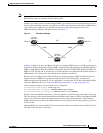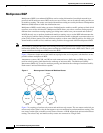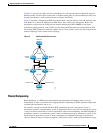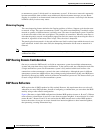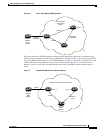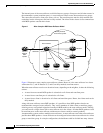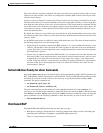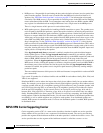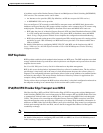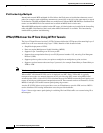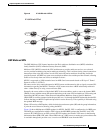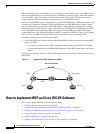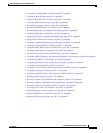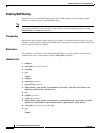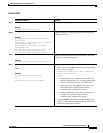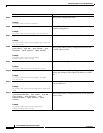
Implementing BGP on Cisco IOS XR Software
Information About Implementing BGP on Cisco IOS XR Software
RC-39
Cisco IOS XR Routing Configuration Guide
OL-14356-01
A backbone carrier offers Border Gateway Protocol and Multiprotocol Label Switching (BGP/MPLS)
VPN services. The customer carrier can be either:
• An Internet service provider (ISP) (By definition, an ISP does not provide VPN service.)
• A BGP/MPLS VPN service provider
You can configure a CSC network to enable BGP to transport routes and MPLS labels between the
backbone carrier provider edge (PE) routers and the customer carrier customer edge (CE) routers using
multiple paths. The benefits of using BGP to distribute IPv4 routes and MPLS label routes are:
• BGP takes the place of an Interior Gateway Protocol (IGP) and Label Distribution Protocol (LDP)
in a VPN routing and forwarding (VRF) table. You can use BGP to distribute routes and MPLS
labels. Using a single protocol instead of two simplifies the configuration and troubleshooting.
• BGP is the preferred routing protocol for connecting two ISPs, mainly because of its routing policies
and ability to scale. ISPs commonly use BGP between two providers. This feature enables those
ISPs to use BGP.
For detailed information on configuring MPLS VPN CSC with BGP, see the Implementing MPLS
Layer 3 VPNs on Cisco IOS XR Software module of Cisco IOS XR Multiprotocol Label Switching
Configuration Guide.
BGP Keychains
BGP keychains enable keychain authentication between two BGP peers. The BGP endpoints must both
comply with draft-bonica-tcp-auth-05.txt and a keychain on one endpoint and a password on the other
endpoint does not work.
See Cisco IOS XR System Security Guide for information on keychain management.
BGP is able to use the keychain to implement hitless key rollover for authentication. The key rollover
specification is time based, and in the event of clock skew between the peers, the rollover process is
impacted. The configurable tolerance specification allows for the accept window to be extended (before
and after) by that margin. This accept window facilitates a hitless key rollover for applications (for
example, routing and management protocols).
The key rollover does not impact the BGP session, unless there is a keychain configuration mismatch at
the endpoints resulting in no common keys for the session traffic (send or accept).
IPv6/IPv6 VPN Provider Edge Transport over MPLS
IPv6 Provider Edge (6PE) and IPv6 VPN Provider Edge (6VPE) leverages the existing Multiprotocol
Label Switching (MPLS) IPv4 core infrastructure for IPv6 transport. 6PE and 6VPE enables IPv6 sites
to communicate with each other over an MPLS IPv4 core network using MPLS label switched paths
(LSPs). This feature relies on multiprotocol Border Gateway Protocol (BGP) extensions in the IPv4
network configuration on the provider edge (PE) router, to exchange IPv6 reachability information in
addition to an MPLS label for each IPv6 address prefix to be advertised. Edge routers are configured to
be dual stack running both IPv4 and IPv6, and use the IPv4-mapped IPv6 address for IPv6 prefix
reachability exchange.
Note This feature is supported on Cisco XR 12000 Series Routers.
For detailed information on configuring 6PE and 6VPE over MPLS, see Cisco IOS XR Multiprotocol
Label Switching Configuration Guide.



